Dehiscence (botany)
Dehiscence is the splitting, at maturity, along a built-in line of weakness in a plant structure in order to release its contents, and is common among fruits, anthers and sporangia. Sometimes this involves the complete detachment of a part. Structures that open in this way are said to be dehiscent. Structures that do not open in this way are called indehiscent, and rely on other mechanisms such as decay or predation to release the contents.
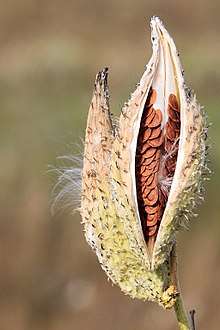
A similar process to dehiscence occurs in some flower buds (e.g., Platycodon, Fuchsia), but this is rarely referred to as dehiscence unless circumscissile dehiscence is involved; anthesis is the usual term for the opening of flowers. Dehiscence may or may not involve the loss of a structure through the process of abscission. The lost structures are said to be caducous.
Association with crop breeding
Manipulation of dehiscence can improve crop yield since a trait that causes seed dispersal is a disadvantage for farmers whose goal is to collect the seed. Many of the agronomically important plants have been bred for reduced shattering.
Mechanisms
Explosive dehiscence
Explosive dehiscence is a ballistic form of dispersal that flings seeds or spores far from the parent plant. This rapid plant movement can achieve limited dispersal without the assistance of animals. A notable example is the sandbox tree (Hura crepitans), which can fling seeds 100 meters (300 ft) and has been called the "dynamite tree" due to the loud sound it generates. Another example is Impatiens, whose explosive dehiscence is triggered by being touched, leading it to be called the "touch-me-not." Ecballium elaterium, the 'squirting cucumber', uses explosive dehiscence to disperse its seeds, ejecting them from matured fruit in a stream of mucilaginous liquid. Explosive dehiscence of sporangia is a characteristic of Sphagnum.[1]
Septicidal and loculicidal dehiscence
Septicidal and loculicidal dehiscence may not be completely distinct; in some cases both the septa and the walls of the locules split.
- Septicidal dehiscence. The septa between the locules of Ledum palustre capsules split as the fruit opens, and the seeds are released.
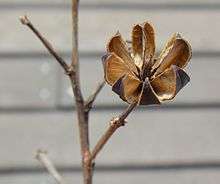 Loculicidal dehiscence. The locules of Lagerstroemia capsules split as the fruit opens, and the septa remain intact.
Loculicidal dehiscence. The locules of Lagerstroemia capsules split as the fruit opens, and the septa remain intact. Loculicidal dehiscence in Peganum harmala
Loculicidal dehiscence in Peganum harmala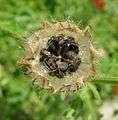 A complex form of dehiscence. The calyx of Hibiscus trionum has opened apically to reveal the capsule (ovary) inside. The capsule has split vertically in the centre, as well as through the locule walls.
A complex form of dehiscence. The calyx of Hibiscus trionum has opened apically to reveal the capsule (ovary) inside. The capsule has split vertically in the centre, as well as through the locule walls.
Types
Dehiscence occurs through breakage of various parts of the enclosing structure; the mechanisms can be classified in various ways, but intermediate forms also occur.
 Transverse dehiscence of a pair of anthers
Transverse dehiscence of a pair of anthers Longitudinal dehiscence of a pair of anthers
Longitudinal dehiscence of a pair of anthers Valvular dehiscence of a pair of anthers
Valvular dehiscence of a pair of anthers Poricidal dehiscence of a pair of anthers
Poricidal dehiscence of a pair of anthers
Poricidal dehiscence
Dehiscence through a small hole (pore) is referred to as poricidal dehiscence. The pore may have a cover (operculate poricidal dehiscense or operculate dehiscence) that is referred to as an operculum or it may not (inoperculate poricidal dehiscense or inoperculate dehiscence).
Poricidal dehiscence occurs in many unrelated organisms, in fruit, causing the release of seeds, and also in the sporangia of many organisms (flowering plants, ferns, fungi, slime molds). Poricidal anthers of various flowers are associated with buzz pollination by insects.
Circumscissile dehiscence
Circumscissile dehiscence involves a horizontal opening that causes a lid to separate completely. This type of dehiscence occurs in some fruit and anthers[2] and also in some flower buds.
Anther dehiscence
Anther dehiscence is the final function of the anther that causes the release of pollen grains. This process is coordinated precisely with pollen differentiation, floral development, and flower opening.
The anther wall breaks at a specific site. Usually this site is observed as an indentation between the locules of each theca and runs the length of the anther, but in species with poricidal anther dehiscence it is instead a small pore. If the pollen is released from the anther through a split on the outer side (relative to the center of the flower), this is extrorse dehiscence, and if the pollen is released from the inner side, this is introrse dehiscence. If the pollen is released through a split that is positioned to the side, towards other anthers, rather than towards the inside or outside of the flower, this is latrorse dehiscence.
The stomium is the region of the anther where dehiscence occurs. The degeneration of the stomium and septum cells is part of a developmentally timed cell-death program. Expansion of the endothecial layer and subsequent drying are also required for dehiscence. The endothecium tissue is responsible for the tensions that lead to splitting of the anther. This tissue is usually one to several layers thick, with cells walls of uneven thickness due to uneven lignification. The cells lose water, and the uneven thickness causes the thinner walls of the cells to stretch to a greater extent. This creates a tension that eventually leads to the anther being split along its line of weakness and releasing pollen grains to the atmosphere.
 Before/During images of anther dehiscence in the common Milk Pea
Before/During images of anther dehiscence in the common Milk Pea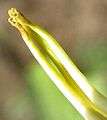 Poricidal anther dehiscence
Poricidal anther dehiscence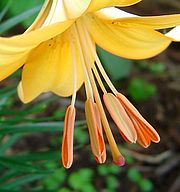 Longitudinal latrorse anther dehiscence
Longitudinal latrorse anther dehiscence
Flower buds
Flower buds of Eucalyptus and related genera open with circumscissile dehiscence. A small cap separates from the remainder of the bud along a circular horizontal zone.
Fruit dehiscence
There are many different types of fruit dehiscence, that involve different types of structures. Some fruits are indehiscent, and do not open to disperse the seeds. Xerochasy is dehiscence that occurs upon drying, and hygrochasy is dehiscence that occurs upon wetting, the fruit being hygroscopic. Dehiscent fruits that are derived from one carpel are follicles or legumes, and those derived from multiple carpels are capsules or siliques.[3]
One example of a dehiscent fruit is the silique. This fruit develops from a gynoecium composed of two fused carpels,[3] which, upon fertilization, grow to become a silique that contains the developing seeds. After seed maturation, dehiscence takes place, and valves detach from the central septum freeing the seeds. This is also known as shattering and can be important as a seed dispersal mechanism. This process is similar to anther dehiscence and the region that breaks (dehiscence zone) runs the entire length of the fruit between the valves (the outer walls of the ovary) and the replum (the persisting septa of the ovary). At maturity, the dehiscence zone is effectively a non-lignified layer between two regions of lignified cells in the valve and the replum. Shattering occurs due to the combination of cell wall loosening in the dehiscence zone and the tensions established by the differential mechanical properties of the drying cells.
- Poppy fruit showing poricidal dehiscence; the seeds exit through pores beneath the "crown"

 Thlaspi arvense, with fruit that are dehiscent siliques
Thlaspi arvense, with fruit that are dehiscent siliques Rhododendron capsules have septicidal dehiscence; the fruit splits through the septa between the carpels
Rhododendron capsules have septicidal dehiscence; the fruit splits through the septa between the carpels
 Anagallis fruits open with circumscissile dehiscence. A small cap separates from the remainder of the fruit along a circular horizontal zone.
Anagallis fruits open with circumscissile dehiscence. A small cap separates from the remainder of the fruit along a circular horizontal zone. Anagallis fruit, circumscissile dehiscence
Anagallis fruit, circumscissile dehiscence_capsule_dehisced.jpg) Spathoglottis plicata capsules, like in most orchids, split longitudinally along three to six slits while remaining closed at both ends
Spathoglottis plicata capsules, like in most orchids, split longitudinally along three to six slits while remaining closed at both ends
Sporangium dehiscence in bryophytes
Endothecium tissue found in moss capsules functions in a similar way in dehiscence to the endothecium in the walls of anthers (see above).
Sporangium dehiscence in ferns
Many leptosporangiate ferns have an annulus around the sporangium, which ejects the spores. Eusporangiate ferns do not generally have specialized dehiscence mechanisms.
 Sporangium dehiscence through a horizontal slit in Botrychium, a eusporangiate fern.
Sporangium dehiscence through a horizontal slit in Botrychium, a eusporangiate fern.
Sporangium dehiscence in fungi and myxomycetes
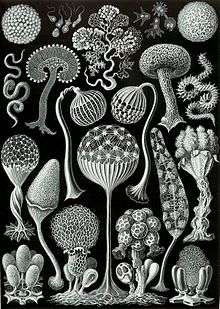 Various sporangia of myxomycetes that dehisce in varied ways
Various sporangia of myxomycetes that dehisce in varied ways
See also
- Abscission—separation of structures that leads to their loss
- Anthesis—the opening of flowers
- Elaters—structures that form inside a sporangium and aid in spore dispersal of horsetails, liverworts, and hornworts
- Loment—a type of fruit that breaks apart but is not dehiscent
- Schizocarp—a type of fruit that breaks apart and may or may not be dehiscent.
References
- "Image Gallery - page 2". rbg-web2.rbge.org.uk.
- Hickey, M.; King, C. (2001). The Cambridge Illustrated Glossary of Botanical Terms. Cambridge University Press.
- Esau, K. 1977. Anatomy of seed plants. John Wiley and Sons, New York.
Bibliography
- Hickey, Michael; King, Clive (2000). The Cambridge illustrated glossary of botanical terms. Cambridge: Cambridge University Press. ISBN 978-0-521-79401-5.CS1 maint: ref=harv (link)

